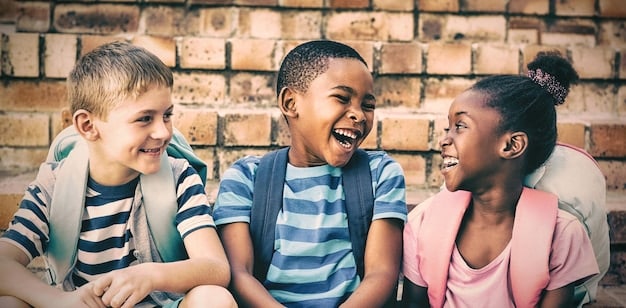Boost Social Skills: Strategies for Children’s Friendships

Teaching children healthy social skills is fundamental for their emotional well-being and successful development, equipping them with the tools needed to form meaningful friendships and navigate complex social interactions from an early age.
In a world increasingly driven by digital connections, the timeless art of genuine human interaction remains paramount, especially for our youngest learners. Learning how to promote healthy social skills in children: strategies for building friendships is not merely about teaching manners; it’s about equipping them with the foundational tools for emotional intelligence, empathy, and resilience. This comprehensive guide delves into actionable strategies that empower parents, educators, and caregivers to foster environments where children can thrive socially, cultivating connections that last a lifetime.
understanding the foundations of social skills
Social skills are the invisible threads that weave the fabric of human connection. For children, these skills are not innate but developed through observation, practice, and guided learning. Understanding the fundamental components of social competence is the first step toward effectively nurturing them.
At its core, social skill development involves a blend of emotional regulation, effective communication, and the ability to interpret social cues. It’s a dynamic process that evolves as children grow, influenced by their environment and the interactions they experience daily. Early intervention and consistent support are crucial in establishing a strong social foundation.
the role of emotional intelligence
Emotional intelligence forms the bedrock of healthy social interactions. When children can identify and manage their own emotions, they are better equipped to understand and respond to the feelings of others. This empathy is vital for forming connections.
Teaching emotional literacy involves helping children name their feelings, express them appropriately, and develop coping mechanisms for challenging emotions. This self-awareness translates directly into improved social interactions, reducing conflict and fostering understanding.
- Recognizing and naming emotions (e.g., happy, sad, angry, frustrated)
- Expressing feelings constructively (e.g., using “I feel” statements)
- Developing coping strategies for big emotions (e.g., deep breaths, taking a break)
- Understanding how their actions impact others’ feelings
Empowering children with this emotional toolkit allows them to navigate the complexities of friendships with greater confidence and compassion. It moves them beyond instinctual reactions to thoughtful responses, essential for productive social problem-solving.
creating a supportive environment for social development
Children learn best in environments where they feel safe, valued, and encouraged to explore. A supportive setting naturally promotes the development of social skills, offering frequent opportunities for interaction and learning.
This goes beyond simply placing children together; it involves intentionally structuring spaces and activities that encourage cooperation, empathy, and reciprocal play. Both home and educational settings play critical roles in shaping a child’s social landscape.
structured play opportunities
Organized playdates, group activities, and team sports provide valuable frameworks for social learning. These settings naturally present scenarios where children must practice sharing, taking turns, negotiating, and resolving minor conflicts.
While free play is vital, a degree of structure can guide children toward positive social behaviors. Adults can facilitate these interactions by suggesting cooperative games, assigning roles, and gently mediating disagreements when necessary, allowing children to practice newly learned skills in a safe space.
- Arranging playdates with compatible peers
- Enrolling children in group activities like scouting or drama clubs
- Encouraging participation in team sports
- Setting up collaborative art or building projects
By providing these structured opportunities, adults create a low-stakes environment for children to experiment with different social roles and communication styles, building confidence in their ability to connect with others.

teaching effective communication and active listening
The ability to communicate clearly and listen attentively is fundamental to forming and maintaining friendships. For children, these skills need explicit teaching and consistent reinforcement.
Rather than just talking at children, teaching them to talk with others involves modeling appropriate conversation techniques, encouraging them to voice their thoughts, and valuing their contributions in discussions.
modeling positive communication
Children are keen observers, and they often imitate the communication styles they see modeled by adults. Demonstrating respectful dialogue, active listening, and appropriate conflict resolution within the family unit sets a powerful example.
This includes making eye contact, using “please” and “thank you,” expressing gratitude, and disagreeing respectfully. When adults model these behaviors consistently, children naturally internalize them as norms for interaction.
- Engaging in family discussions where everyone gets a turn to speak
- Showing active listening through nodding, reflective statements, and open body language
- Using “I” statements when expressing feelings or needs
- Resolving disagreements calmly and constructively in front of children
Consciously modeling positive communication habits transforms everyday interactions into valuable learning opportunities, reinforcing the idea that respectful and clear communication is the cornerstone of all relationships.
practicing active listening skills
Active listening is more than just hearing words; it’s about understanding the message, both verbal and non-verbal. Children can be taught to truly listen by practicing techniques like maintaining eye contact, asking clarifying questions, and summarizing what they’ve heard.
Play role-playing games where children take turns being the speaker and the listener, providing feedback on how well they understood each other. This direct practice makes the concept of active listening tangible and reinforces its importance in building connections.
Encourage children to ask open-ended questions that go beyond simple “yes” or “no” answers. Teach them the value of showing genuine interest in what their friends are saying, which makes others feel heard and valued. Discussions about books or movies can be excellent opportunities to practice summarizing and interpreting characters’ feelings and motivations based on their dialogue.
nurturing empathy and understanding diverse perspectives
Empathy is the cornerstone of social connection, allowing children to step into another’s shoes and understand their feelings and experiences. It is a trainable skill that grows with exposure and guided reflection.
Teaching children to acknowledge and appreciate differences, rather than fear them, broadens their social horizons and promotes inclusivity. This crucial aspect of social development fosters a more compassionate and understanding generation.
exploring emotions through stories and characters
Books, movies, and even puppet play offer powerful avenues for exploring a wide spectrum of emotions and diverse perspectives. Discussing characters’ feelings, motivations, and the impact of their actions helps children develop their emotional vocabulary and empathy.
Ask questions like, “How do you think the character felt when that happened?” or “What would you do if you were in their situation?” This encourages children to think beyond their immediate experience and consider alternative viewpoints, cultivating a deeper understanding of human behavior.
- Reading books that feature characters from diverse backgrounds or with different challenges
- Watching age-appropriate shows and discussing the emotional arcs of the characters
- Engaging in role-play where children act out different emotional scenarios
- Discussing real-life situations from a newspaper or news story (age-appropriately) to foster empathy
These narrative tools provide a safe distance for children to explore complex emotional landscapes, preparing them to apply these insights to their real-life interactions. It’s a gentle yet effective way to build their capacity for compassion.
strategies for conflict resolution and problem-solving
Conflicts are an inevitable part of human interaction, and for children, they are crucial learning opportunities. Teaching effective conflict resolution skills equips children to navigate disagreements constructively, turning potential breakdowns into opportunities for growth and stronger friendships.
The goal is not to avoid conflict entirely, but to provide children with the tools to manage it respectfully, encouraging them to find mutually agreeable solutions rather than resorting to aggression or withdrawal.

teaching the ‘stop, think, act’ approach
A simple yet effective strategy for conflict resolution is the “Stop, Think, Act” model. This helps children pause before reacting impulsively, encouraging them to consider the situation and potential outcomes.
“Stop” means pausing when a conflict arises. “Think” involves considering their feelings, the other person’s feelings, and possible solutions. “Act” refers to choosing a constructive response. This structured approach helps children develop self-regulation and thoughtful decision-making abilities.
- Encouraging a brief pause during disagreements (e.g., “Let’s take a deep breath”)
- Guiding children to identify the core issue of the conflict
- Brainstorming multiple solutions (e.g., sharing, taking turns, finding a compromise)
- Discussing the potential consequences of different actions
By internalizing this process, children gain confidence in their ability to handle conflicts independently and peacefully, strengthening their friendships by fostering mutual respect and understanding.
negotiation and compromise
Friendships flourish when children learn the art of negotiation and compromise. These skills involve understanding that not everyone can always get their way, and finding solutions where both parties feel heard and valued.
Practice scenarios where children need to share resources or decide on a joint activity. Guide them through the process of articulating their desires, listening to their friend’s perspective, and finding a middle ground that satisfies both. This process builds resilience and fosters a spirit of cooperation.
Encourage them to articulate their own needs clearly, such as “I want to play with the blue block now.” Then, prompt them to actively listen to their friend’s perspective: “What do you want to play with?” Suggesting phrases like, “Maybe we can play with it together, or I can use it for five minutes and then you can have a turn,” helps them grasp the concept of mutual concession. This teaches them that finding solutions is a two-way street, where everyone gives a little to gain a harmonious outcome. This reinforces the idea that friendships are built on give-and-take, not just take.
fostering resilience and handling social challenges
Social interactions are not always smooth; children will inevitably encounter challenges like rejection, bullying, or misunderstandings. Equipping them with resilience helps them navigate these bumps and emerge stronger.
The ability to bounce back from social setbacks is crucial for long-term emotional well-being and continued social engagement. It’s about teaching children that setbacks are learning opportunities, not reasons to disengage.
building self-confidence and assertiveness
A strong sense of self-worth is a powerful shield against social pressures and rejections. When children believe in themselves, they are better equipped to assert their needs, stand up for themselves, and cope with challenging social situations.
Encourage children to pursue their interests, celebrate their achievements, and acknowledge their unique strengths. Teach them the difference between aggression and assertiveness, emphasizing the importance of expressing their thoughts and feelings respectfully but firmly.
- Praising effort and perseverance, not just outcomes
- Encouraging participation in activities they enjoy and excel at
- Role-playing scenarios for asserting boundaries (e.g., “No, I don’t want to play that game”)
- Discussing the importance of self-respect and standing up for what is right
A confident child is more likely to engage positively with peers, seek out new friendships, and recover more quickly from social difficulties. This inner strength is a crucial component of healthy social development.
the role of parents and caregivers in promoting social skills
Parents and caregivers are the primary architects of a child’s early social environment. Their influence is profound, shaping everything from a child’s foundational understanding of relationships to their ability to navigate complex social situations.
Active involvement, consistent guidance, and a nurturing approach are the most powerful tools in a parent’s arsenal when it comes to fostering robust social skills and enduring friendships.
being a social role model
Children learn by observing. When parents exhibit healthy social behaviors—such as empathy, respectful communication, conflict resolution, and kindness—they provide a living blueprint for their children to follow. This modeling extends to how parents interact with each other, with friends, and even with strangers in public.
Consciously demonstrating these behaviors, and even narrating them (“I’m going to take a deep breath because I’m feeling a little frustrated,” or “Let’s ask Grandma how her day was, showing we care”), makes the learning process explicit and tangible for children. It imbues everyday interactions with social lessons.
providing constructive feedback and guidance
When social challenges arise, parents have a unique opportunity to provide real-time coaching. Instead of solving problems for children, guide them through the process of identifying issues, brainstorming solutions, and evaluating outcomes. This empowers them to become independent social problem-solvers.
This includes feedback on body language, tone of voice, and the impact of their words. For example, “When you interrupt, it makes it hard for your friend to finish their thought,” or “Your voice was a little loud there; try using a softer tone.” Such specific and gentle guidance helps children connect their actions to social outcomes.
- Discussing social situations after they happen, focusing on what went well and what could be done differently
- Role-playing difficult conversations or interactions
- Offering specific praise for positive social behaviors (e.g., “I noticed how kindly you shared your toy with your brother”)
- Avoiding over-scheduling children, allowing downtime for unstructured social play
This active, responsive guidance validates a child’s efforts and helps them refine their social repertoire. It transforms moments of struggle into powerful learning experiences that build resilience and social competence.
| Key Strategy | Brief Description |
|---|---|
| 💖 Foster Empathy | Encourage children to understand and share the feelings of others through stories and discussions. |
| 🗣️ Teach Communication | Model and practice active listening, clear expression, and respectful dialogue. |
| 🤝 Encourage Conflict Resolution | Equip kids with strategies like “Stop, Think, Act” and the art of compromise. |
| 🏡 Provide Supportive Environment | Create safe spaces and opportunities for varied social interactions and learning. |
Frequently Asked Questions About Children’s Social Skills
The most crucial social skills for young children include empathy, sharing, taking turns, active listening, and effective communication. These foundational skills enable them to understand others’ perspectives, cooperate in group settings, and express their own needs and feelings constructively, forming the basis for healthy relationships.
Parents might notice a child consistently struggling to make or keep friends, engaging in frequent conflicts without resolution, having difficulty understanding social cues, or showing extreme shyness or aggression in group settings. Observing these patterns can indicate a need for focused support in social skill development.
Play is paramount for social skill development, as it provides a natural, low-stakes environment for children to experiment with different social roles, practice communication, negotiate, share, and resolve conflicts. Structured and unstructured play settings both offer invaluable opportunities for social learning and peer interaction.
While social skill development is continuous, certain milestones are generally observed. For instance, toddlers learn parallel play, preschoolers engage in cooperative play and sharing, and elementary-aged children develop more complex friendships requiring negotiation and empathy. However, individual development can vary, and consistent opportunities are key.
Parents should consider seeking professional help from a pediatrician, child psychologist, or school counselor if persistent social difficulties significantly impact their child’s well-being, such as severe anxiety in social situations, extreme isolation, or inability to manage anger or aggression during interactions despite consistent guidance.
Conclusion
Fostering healthy social skills in children is an ongoing journey that requires patience, observation, and consistent effort from parents and caregivers. By providing supportive environments, teaching effective communication, nurturing empathy, and equipping children with conflict resolution tools, we empower them to build strong, meaningful friendships. These foundational skills extend far beyond the playground, preparing them for a lifetime of successful relationships, emotional resilience, and active participation in their communities. Investing in a child’s social development is truly an investment in their future happiness and well-being.





